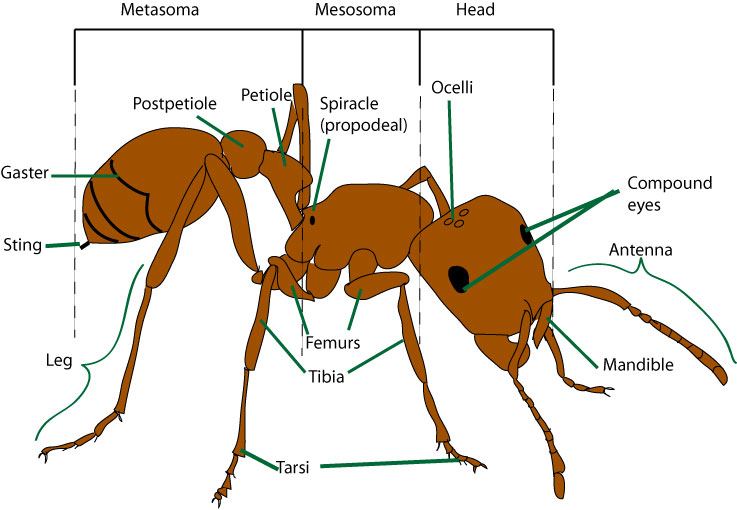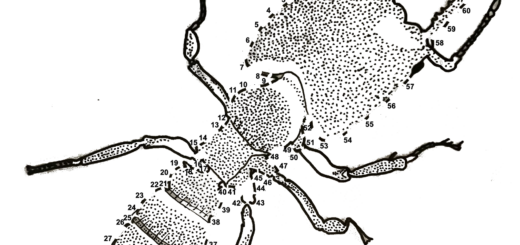Ant anatomy (ant morphology)
Hello Young Readers,
Our first post is going to be about different ant parts – what are they called, how different these parts look like, and also how to identify them. Don’t be scared, it’s going to be a joyful ride, we promise you! With pictures illustrating what is and what is not an ant, and what are the different ant parts – all in an easy way. Once you get acquainted with the terms, we also have an interesting crossword to solve inside an ant nest. Want to know more, wait no further!! We have a list of ‘Resources’ just for you to know more about ants and look at the different pictures of ants found on the globe.
Get ready to fill your school bag with different ant pictures and information.
Jet set go!!
Table of Contents:
- What is and what is not an ant?
- What are the different ant parts?
- Activities to do
- Vocabulary learned from this post
- Resources
- Ant crossword
Created by Roberta Gibson and Sheethal Vepur

1. What is and what is not an ant?
To talk about ants, first, we need to be able to identify them.
Is this an ant?

Is this an ant?

2. What are the different parts of an ant?
How do you tell which are ants?
Let’s take a look at the parts that make up an ant, called their “anatomy”.

You might have heard insects have three body parts: the head, thorax, and abdomen. Ants, however, are different.
Ants have a thin section – like a “waist” – between what would normally be called the thorax and abdomen. When adult ants are developing their thin waists in the pupa stage, a bit of the true abdomen gets pressed up against the thorax, and the rest of the abdomen becomes the waist and the hind section. When ant biologists realized this they thought, “Hum, we can’t really call that middle section a thorax, if it’s really a thorax and a bit of abdomen pushed together. And we can’t call the back section an abdomen if it is only part of the abdomen… so we’ll call the middle part a mesosoma (sometimes alitrunk) and the back part a gaster (or a metasoma.)”
The thin waist between the mesosoma and gaster is called the petiole. If there are two thin segments between the mesosoma and gaster, the second one is called a postpetiole. The bit of the abdomen that got mushed with the thorax is called the propodeum. The head is still a head. Insects have six legs and so do adult ants. They also have feet, which are called tarsi.
Many adult insects have wings. In ants, the queens and males have wings (we’ll learn more about those later). The workers do not have wings. Most ants have eyes. They have two compound eyes that most people can see and three tiny eyes called ocelli that are best seen under a hand lens or microscope. A few kinds of ants, like army ants, have no eyes at all.
Like other insects, ants have two antennae, which they use as a nose to smell things. They also use their antennae to touch things. What are their mouths like? Ants have a pair of jaws called mandibles. They can use them to cut food, like a pair of scissors. They can also use their mandibles to carry things. Do ants have a sting? Some ants do have a sting, like their wasp and bee cousins. Others do not have stings.
Finally, ants need a way to move air into their bodies. Ants, like all insects, have openings in their sides called spiracles to allow air in. Adults have 10 (or sometimes 9) spiracles on each side of the body.
You’ve learned a lot of big words today. As you learn to use them, you will begin to see how ants are different from other insects. You will also see how some kinds of ants have different parts than others. You are on the way to becoming a myrmecologist.
3. Activities to do:
1. Look back at the photographs above. Can you spot which one is the ant now?
2. Grab some more photos of ants and see if you can find the parts we’ve described. How do the parts look different in different kinds of ants?
4. Vocabulary:
Head
Mesosoma
Gaster
Petiole
Postpetiole
Leg
Eye (or compound eye)
Ocellus (ocelli)
Wing
Antenna (antennae)
Sting
Mandible
Tarsi
Spiracles
5. Resources:
Explore Ant Anatomy
Color and label these anatomy coloring pages
Alex Wild’s images of ants
https://www.alexanderwild.com/
If you enjoyed this post, we would greatly appreciate any feedback, so we can adjust the posts for the kids section accordingly.
Please note: We used “anatomy” here because it is a more common term for non-scientists, but now also added the term “morphology” for clarification. We thank Claude Lebas for bringing this to our attention.





This is not anatomy but morphology.
Or, in French, the difference between the two:
https://www.youtube.com/watch?v=VmHvfPgQNw8
Thank you for bringing this to our attention.